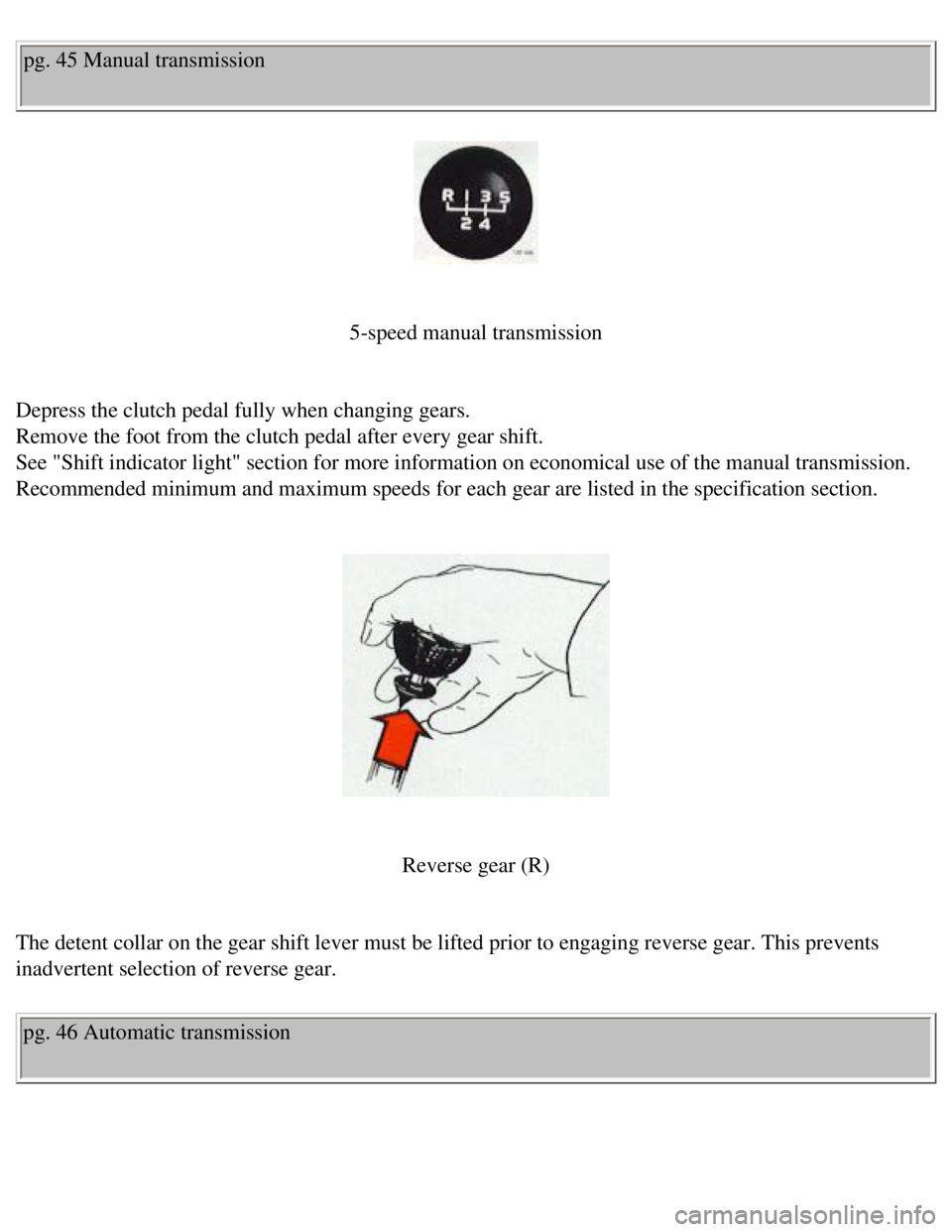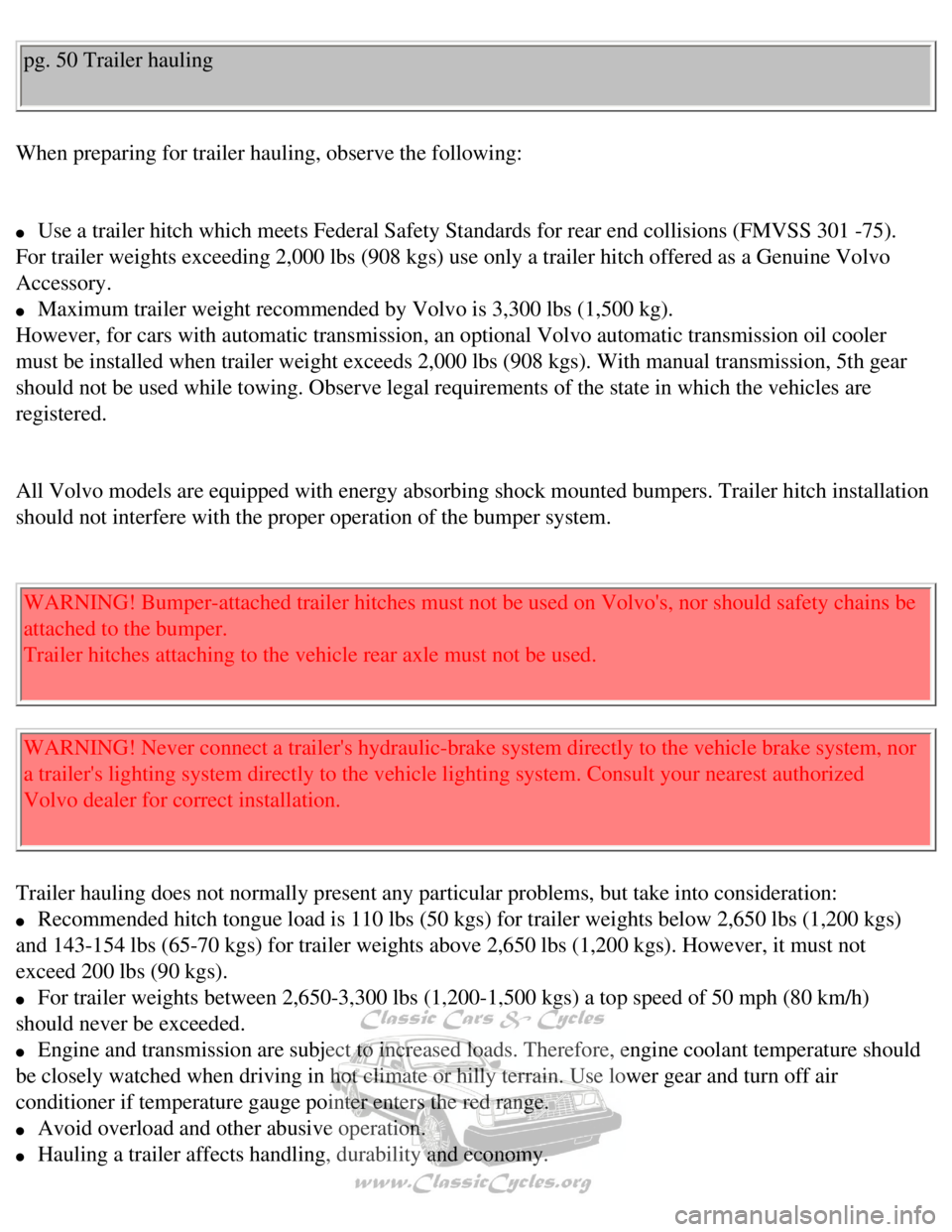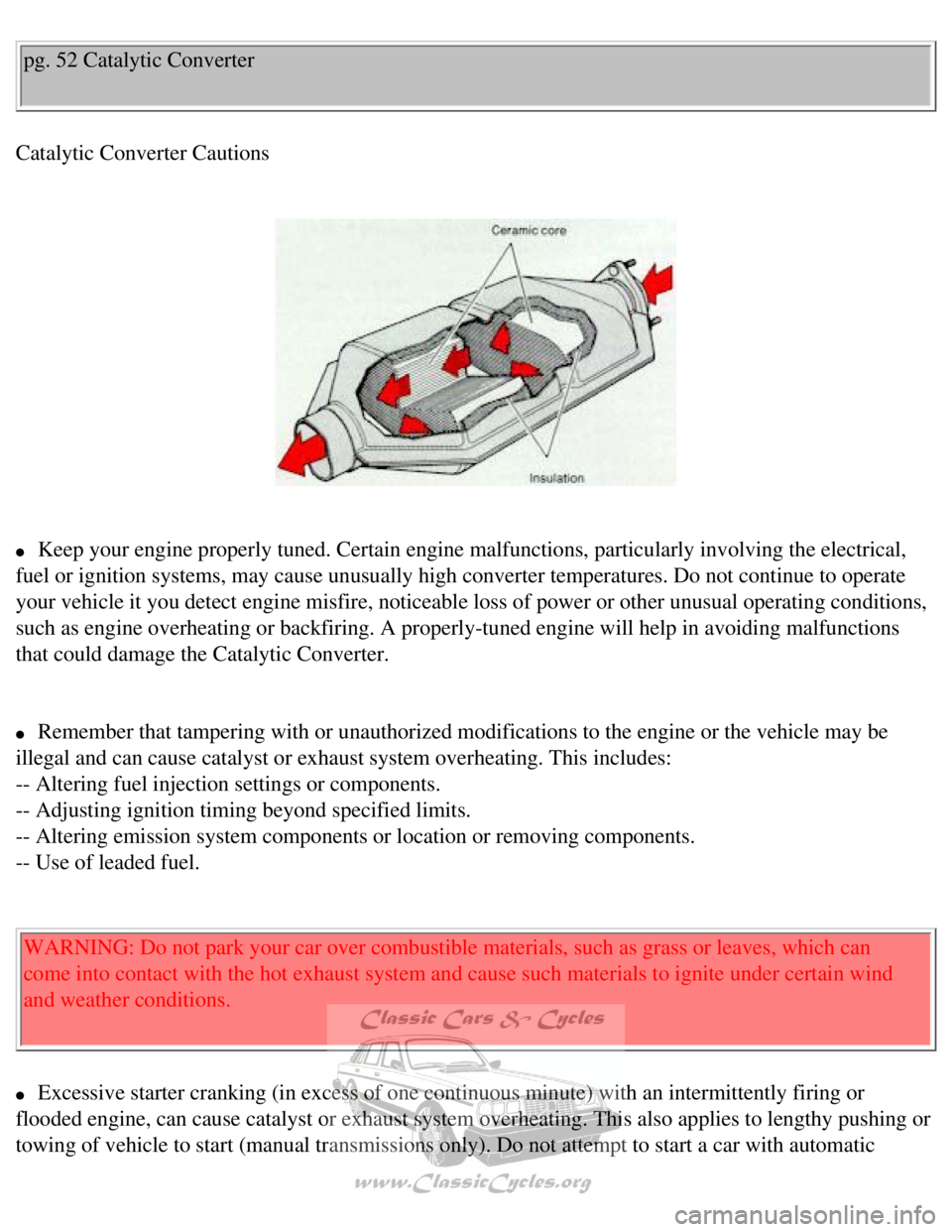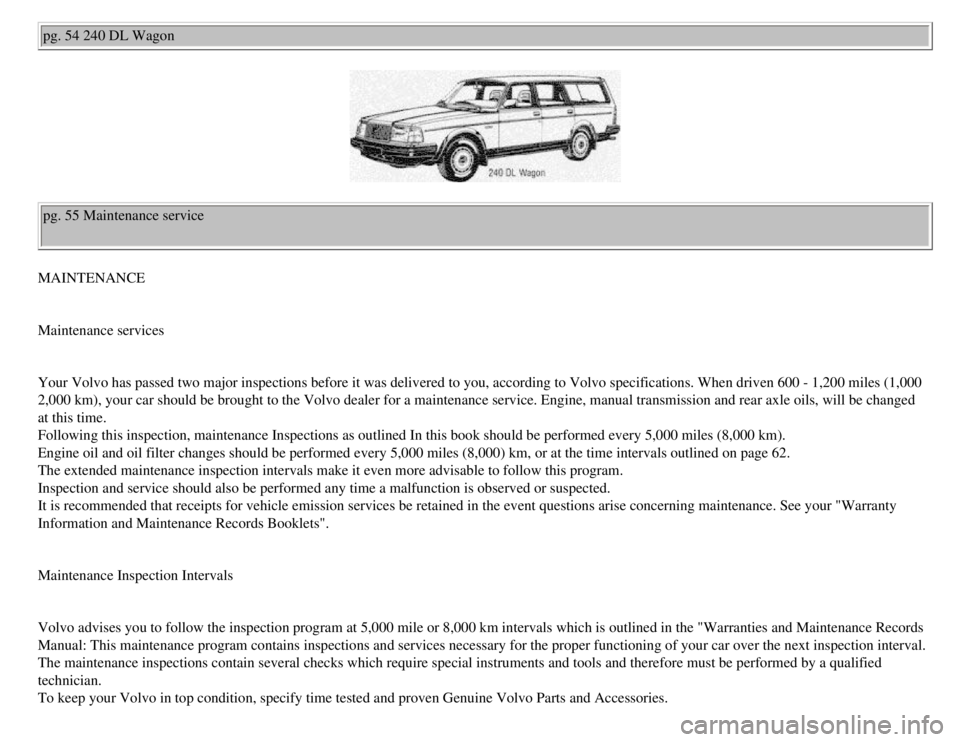1990 VOLVO 240 manual transmission
[x] Cancel search: manual transmissionPage 9 of 143

Volvo 1990 240 Model
N Trip odometer
O High beam indicator (blue)
P Parking brake reminder light (red)
Q Brake failure warning light (red)
R Bulb failure warning light (yellow)
S Overdrive OFF indicator light (yellow)
(automatic transmission models)
Shift indicator light (yellow)
(manual transmission models)
Contents | Top of Page
file:///K|/ownersdocs/1990/1990_240/90240_01.htm (5 of 5)12/30/2006 8:\
25:01 AM
Page 51 of 143

Volvo 1990 240 Model
pg. 41 Operating the car
42Service inspection
42Break-in period
43Driving economy, shift indicator light
44Starting the engine
45Manual transmission
46Automatic transmission
48Emergency towing
49Towing information
50Trailer hauling
51Automatic transmission, brake system
52Catalytic converter
pg. 42 Break-in period, Service inspection
A new car should be broken-in!
Manual transmission
During the break-in period do not exceed the following speeds*:
First 600 miles (1,000 km)
1st gear 20
mph
(30 km/h)
2nd
gear 30
mph
(50 km/h)
file:///K|/ownersdocs/1990/1990_240/90240_09.htm (1 of 6)12/30/2006 8:\
25:05 AM
Page 54 of 143

Volvo 1990 240 Model
l Avoid using automatic transmission kick-down feature unless necessary.
Other factors which decrease gas mileage are:
l Worn or dirty spark plugs
l Incorrect spark plug gap
l Dirty air filter
l Incorrect valve clearance
l Incorrect idle speed
l Dirty engine oil and clogged oil filter
l Dragging brakes
l Incorrect front end alignment
l Low tire pressure
Shift indicator light
(manual transmission models only)
The Volvo shift indicator light (S.I.L.) is a device designed to help \
you get even better gas mileage from
your Volvo car. Studies have shown that the best fuel economy is obtaine\
d by shifting gears at low
engine rpm and high relative engine load. The Volvo S.I.L. is calibrated\
to show you when to shift for
improved mileage without sacrificing smooth acceleration .
Use of the S.I.L. is simple. Shift to next higher gear as soon as the li\
ght comes on. You may find after
using the S.I.L. for some time that your natural shifting rhythm will ad\
apt to the S.I.L.'s suggestion.
Some drivers may even shift before the light comes on.
Obviously, there will be times when you need to shift later than the lig\
ht would indicate (for example,
when climbing hills or trailer towing). Using the light regularly, howe\
ver, should result in a mileage
improvement of six percent or more, depending on how you normally drive.\
Programming instructions for shift indicator
If the current supply to the control unit is cut (battery disconnected)\
, the control unit will have to be re-
programmed as the control unit memory will be erased.
Drive the car in each gear (first gear not necessary) for approximatel\
y 8 seconds.
The gear change indicator light will flicker once (0.5 seconds), as ea\
ch gear is programmed.
file:///K|/ownersdocs/1990/1990_240/90240_09.htm (4 of 6)12/30/2006 8:\
25:05 AM
Page 55 of 143

Volvo 1990 240 Model
Note: Remove foot completely from the clutch pedal after each gear chang\
e when programming the
control unit.
pg. 44 Starting the engine
To start the engine;
1 Enter the car and check that the seat is adjusted properly. Make sure \
that the brake (and clutch) pedal
can be depressed completely. Move the seat closer if necessary.
2 Fasten the seat belt.
3 Apply the parking brake if not already set. Depress the brake pedal wi\
th your right foot.
4 Place the gear selector lever in neutral (position N or P, automatic \
transmission).
5 Depress the clutch pedal (manual transmission).
6 Without touching the accelerator pedal turn the ignition key to starti\
ng position. Release the key as
soon as the engine starts.
Avoid repeated short attempts to start (fuel is injected every time the\
starter is engaged when engine is
cold).
Allow the starter to operate for a longer time (but not more than 15-20\
seconds).
Do not race a cold engine immediately starting.
Engine warm-up-initial driving procedure
Experience shows that engines in vehicles driven short distances are sub\
ject to abnormally rapid wear
because the engine never reaches normal operating temperature.
It is therefore beneficial to reach normal operating temperature as soon\
as possible by driving with a
light foot on the accelerator pedal.
Warning: Always open the garage doors fully before starting the engine i\
nside the garage to ensure
adequate ventilation. The exhaust gases contain carbon monoxide, which i\
s invisible and odorless but
very poisonous.
file:///K|/ownersdocs/1990/1990_240/90240_09.htm (5 of 6)12/30/2006 8:\
25:05 AM
Page 57 of 143

Volvo 1990 240 Model
pg. 45 Manual transmission
5-speed manual transmission
Depress the clutch pedal fully when changing gears.
Remove the foot from the clutch pedal after every gear shift.
See "Shift indicator light" section for more information on economical u\
se of the manual transmission.
Recommended minimum and maximum speeds for each gear are listed in the s\
pecification section.
Reverse gear (R)
The detent collar on the gear shift lever must be lifted prior to engagi\
ng reverse gear. This prevents
inadvertent selection of reverse gear.
pg. 46 Automatic transmission
file:///K|/ownersdocs/1990/1990_240/90240_10.htm (1 of 7)12/30/2006 8:\
25:05 AM
Page 64 of 143

Volvo 1990 240 Model
pg. 50 Trailer hauling
When preparing for trailer hauling, observe the following:
l Use a trailer hitch which meets Federal Safety Standards for rear end co\
llisions (FMVSS 301 -75).
For trailer weights exceeding 2,000 lbs (908 kgs) use only a trailer h\
itch offered as a Genuine Volvo
Accessory.
l Maximum trailer weight recommended by Volvo is 3,300 lbs (1,500 kg). \
However, for cars with automatic transmission, an optional Volvo automat\
ic transmission oil cooler
must be installed when trailer weight exceeds 2,000 lbs (908 kgs). Wit\
h manual transmission, 5th gear
should not be used while towing. Observe legal requirements of the state\
in which the vehicles are
registered.
All Volvo models are equipped with energy absorbing shock mounted bumper\
s. Trailer hitch installation
should not interfere with the proper operation of the bumper system.
WARNING! Bumper-attached trailer hitches must not be used on Volvo's, no\
r should safety chains be
attached to the bumper.
Trailer hitches attaching to the vehicle rear axle must not be used.
WARNING! Never connect a trailer's hydraulic-brake system directly to th\
e vehicle brake system, nor
a trailer's lighting system directly to the vehicle lighting system. Con\
sult your nearest authorized
Volvo dealer for correct installation.
Trailer hauling does not normally present any particular problems, but t\
ake into consideration:
l Recommended hitch tongue load is 110 lbs (50 kgs) for trailer weights \
below 2,650 lbs (1,200 kgs)
and 143-154 lbs (65-70 kgs) for trailer weights above 2,650 lbs (1,20\
0 kgs). However, it must not
exceed 200 lbs (90 kgs).
l For trailer weights between 2,650-3,300 lbs (1,200-1,500 kgs) a top sp\
eed of 50 mph (80 km/h)
should never be exceeded.
l Engine and transmission are subject to increased loads. Therefore, engin\
e coolant temperature should
be closely watched when driving in hot climate or hilly terrain. Use low\
er gear and turn off air
conditioner if temperature gauge pointer enters the red range.
l Avoid overload and other abusive operation.
l Hauling a trailer affects handling, durability and economy.
file:///K|/ownersdocs/1990/1990_240/90240_11.htm (1 of 6)12/30/2006 8:\
25:06 AM
Page 68 of 143

Volvo 1990 240 Model
pg. 52 Catalytic Converter
Catalytic Converter Cautions
l Keep your engine properly tuned. Certain engine malfunctions, particular\
ly involving the electrical,
fuel or ignition systems, may cause unusually high converter temperature\
s. Do not continue to operate
your vehicle it you detect engine misfire, noticeable loss of power or o\
ther unusual operating conditions,
such as engine overheating or backfiring. A properly-tuned engine will h\
elp in avoiding malfunctions
that could damage the Catalytic Converter.
l Remember that tampering with or unauthorized modifications to the engine\
or the vehicle may be
illegal and can cause catalyst or exhaust system overheating. This inclu\
des:
-- Altering fuel injection settings or components.
-- Adjusting ignition timing beyond specified limits.
-- Altering emission system components or location or removing component\
s.
-- Use of leaded fuel.
WARNING: Do not park your car over combustible materials, such as grass \
or leaves, which can
come into contact with the hot exhaust system and cause such materials t\
o ignite under certain wind
and weather conditions.
l Excessive starter cranking (in excess of one continuous minute) with a\
n intermittently firing or
flooded engine, can cause catalyst or exhaust system overheating. This a\
lso applies to lengthy pushing or
towing of vehicle to start (manual transmissions only). Do not attempt\
to start a car with automatic
file:///K|/ownersdocs/1990/1990_240/90240_11.htm (5 of 6)12/30/2006 8:\
25:06 AM
Page 71 of 143

Volvo 1990 240 Model
pg. 54 240 DL Wagon
pg. 55 Maintenance service
MAINTENANCE
Maintenance services
Your Volvo has passed two major inspections before it was delivered to y\
ou, according to Volvo specifications. When driven 600 - 1,200 miles (1,000
2,000 km), your car should be brought to the Volvo dealer for a mainten\
ance service. Engine, manual transmission and rear axle oils, will be changed
at this time.
Following this inspection, maintenance Inspections as outlined In this b\
ook should be performed every 5,000 miles (8,000 km).
Engine oil and oil filter changes should be performed every 5,000 miles \
(8,000) km, or at the time intervals outlined on page 62.
The extended maintenance inspection intervals make it even more advisabl\
e to follow this program.
Inspection and service should also be performed any time a malfunction i\
s observed or suspected.
It is recommended that receipts for vehicle emission services be retaine\
d in the event questions arise concerning maintenance. See your "Warranty
Information and Maintenance Records Booklets".
Maintenance Inspection Intervals
Volvo advises you to follow the inspection program at 5,000 mile or 8,00\
0 km intervals which is outlined in the "Warranties and Maintenance Records
Manual: This maintenance program contains inspections and services neces\
sary for the proper functioning of your car over the next inspection interval.
The maintenance inspections contain several checks which require special\
instruments and tools and therefore must be performed by a qualified
technician.
To keep your Volvo in top condition, specify time tested and proven Genu\
ine Volvo Parts and Accessories.
file:///K|/ownersdocs/1990/1990_240/90240_12.htm (2 of 7)12/30/2006 8:\
25:07 AM